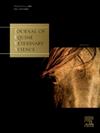先进的马十二指肠镜技术
IF 1.6
3区 农林科学
Q2 VETERINARY SCIENCES
引用次数: 0
摘要
十二指肠病变在马医学中被低估,可能不是因为很少发生,而是由于当前诊断技术的限制。本报告的目的是描述一种新的十二指肠镜方法,允许通过标准技术无法实现的区域的完整可视化。胃十二指肠镜检查是在临床设置在60成年马转介给我们,由于投诉怀疑与胃十二指肠疾病有关。该过程的最初步骤是使用先前发表的技术进行的。一旦视频内窥镜到达颅十二指肠,在直接看到主要十二指肠乳头之前,进行缓慢和控制的后旋操作,允许对幽门括约肌的十二指肠面和十二指肠的整个颅面进行完整检查。所描述的技术可以更好地进行十二指肠镜检查,而不会危及邻近粘膜的病变,并允许宽视野避免盲点。本文章由计算机程序翻译,如有差异,请以英文原文为准。
Advanced equine duodenoscopy technique
Duodenal pathologies are underreported in equine medicine, probably not due to little occurrence, but due to the limitations of current diagnostic techniques. The aim of this report is to describe a novel duodenoscopic approach, that allows a complete visualization of a region inaccessible via standard techniques. Gastroduodenoscopy was performed in a clinical setting in 60 adult horses referred to us due to complaints suspected to be related to gastroduodenal diseases. The initial steps of the procedure were performed using previously published techniques. Once the video-endoscope reached the cranial duodenum and before direct visualization of the major duodenal papilla, a slow and controlled retroflexion maneuver was performed, allowing a complete examination of the duodenal face of the pyloric sphincter and the whole cranial aspect of the duodenum. The technique described allowed better duodenoscopy examination, without risking lesions of the adjacent mucosa and allowed a wide field of view avoiding blind spots.
求助全文
通过发布文献求助,成功后即可免费获取论文全文。
去求助
来源期刊

Journal of Equine Veterinary Science
农林科学-兽医学
CiteScore
2.70
自引率
7.70%
发文量
249
审稿时长
77 days
期刊介绍:
Journal of Equine Veterinary Science (JEVS) is an international publication designed for the practicing equine veterinarian, equine researcher, and other equine health care specialist. Published monthly, each issue of JEVS includes original research, reviews, case reports, short communications, and clinical techniques from leaders in the equine veterinary field, covering such topics as laminitis, reproduction, infectious disease, parasitology, behavior, podology, internal medicine, surgery and nutrition.
 求助内容:
求助内容: 应助结果提醒方式:
应助结果提醒方式:


